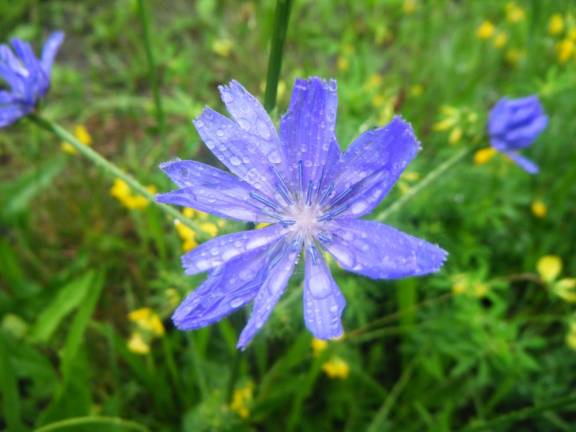Dandelion's upbeat cousin

Take a stroll down a country road, meander through a meadow or simply peer from your window on your next drive, and it’s likely you’ll spy the vibrantly blue flower-face of chicory. This common non-native plant, originally from Europe, has little interest in our thick forests or pristine protected habitats, preferring to root in those places that blur the line between wilderness and civilization.
Chicory’s eye-catching flowers stand on branching rigid stalks nearly four feet tall. The flowers are composed of many ray florets, similar to its relative, dandelion, but squared-tipped and fringed. Basal leaves are three to six inches long and deeply toothed, however those clasping further up the stalk are significantly smaller. Chicory, scientifically called Cichorium intybus, has a long taproot that holds fast to the earth. All parts of this plant exude a milky sap when broken.
Although chicory flowers in summer, it offers food year-round. Leaves are tastiest in spring, growing more bitter as the plant matures. However, this time of year, leaves can still be enjoyed sparingly in salads or tossed in sautés and soups. The stem leaves will be the most palatable. Bear in mind that bitter flavored foods are excellent for stimulating the flow of digestive juices, essential in aiding the breakdown of food and assimilation of nutrients. Pinch chicory flowers from the stalk, pull apart petals and scatter atop salads, bake in quiche, or sprinkle in a crepe for an edible floral accent.
Chicory is best known for its root, which has long been used as an addition to coffee or as a coffee-like substitute. Harvest roots from fall to early spring with a digging knife and a little persistence. Wash, dice and slow roast until brittle and fragrant, then simmer roots in hot water or grind and prepared like you would a cup of coffee. But don’t be misled – chicory does not contain caffeine. Instead, it provides a pick-me-up in the form of nutrients. Roots provide manganese, potassium, vitamin B6, and a prebiotic fiber called inulin that promotes the growth of healthy gut flora.
So next time you spy that pretty blue face gazing your way, take the time to lean in close, offer thanks and partake of its food and medicine.